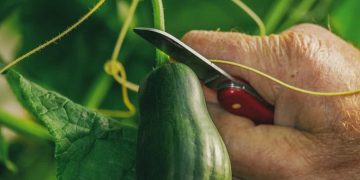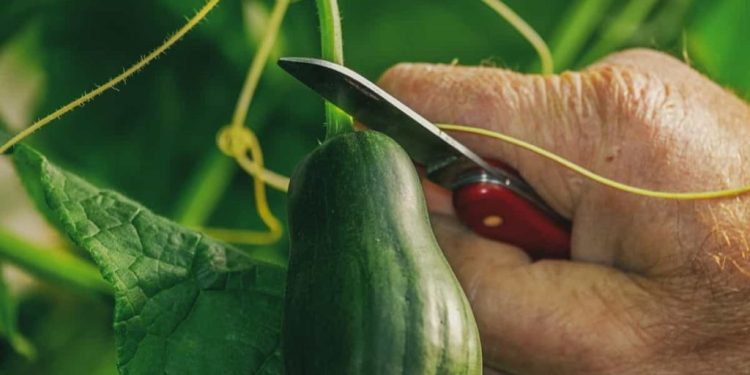Cucumbers (Cucumis sativas) are members of the Cucurbitaceae family, including Squash, Pumpkins, Musk Melons, Watermelons, and Gourds. Cucumbers are produced worldwide, and the United States is the fourth largest producer after China, India, and Russia. Mexico is the primary importer during the winter season to meet year-round demand from US consumers. The best growing zone for Cucumbers in the USA is Zone 5a.
How to start cucumber farming in USA
Conditions for growing Cucumber in the USA
- Cucumbers are warm-season plants and grow best between 18 to 35°C. Cucumbers are grown either in fields or in greenhouses. Cucumber plants grown in the field usually start as seeds and are either mechanically or hand planted.
- Many commercial operations train plants to grow on poles or trellises to keep the fruit suspended. Several training systems are used to grow trellis, but the umbrella system is the most common. In canopy systems, all lateral branches are removed as they appear until the stem reaches a predetermined height. Then, the plant is allowed to grow freer to focus on growing fruit rather than height.
- Some growers plant bushy varieties and let the fruit spread along the ground. To accommodate different harvesting methods, field Cucumbers grown for fresh or cut markets are spaced about 36-72 inches apart versus 8-10 inches for pickles. Unlike field-grown Cucumbers, greenhouse Cucumbers are usually established as transplants.
- Greenhouse Cucumber plants have large leaves and grow vigorously. Each plant has about 5-7 square feet of space and is always grown on a trellis. Cucumbers need close monitoring of nutrients to maintain good health and productivity.
Cucumber varieties in the USA
The best Cucumber varieties in the USA are Bristol, Dasher II, Dominator, General Lee, Intimidator, Mongoose, Python, Speedway, Stonewall, Talladega, Thunder, Suyo Long, and Tasty Green.
- Slicers: Turbo (F1) (multi-disease resistant), Market Moor 80 (multi-disease resistant)
- Pickles: H-19 Little Leaf (multi-disease resistant), Max Pack (Resistant to many diseases)
- Parthenocarpic: Diva (F1), Poniente (F1)
In case you missed it: Top 20 Steps to Boost Cucumber Yield: How to Increase Cucumber Size, Quality, and Production
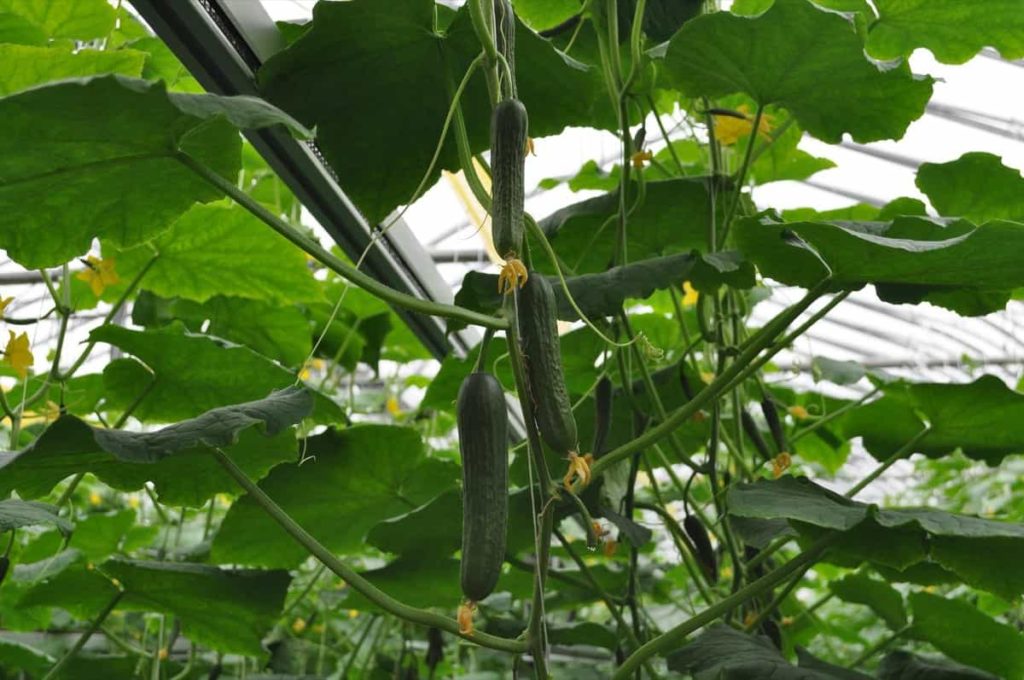
Site selection for Cucumber farming in the USA
Cucumber should be grown on soils with good water infiltration and moisture retention capacity. The soil should not be compacted and should have a pH of 5.8-6.6. Cucumbers are very sensitive to cold, and plants and fruits can be injured by light frost. In addition, cucumbers require a constant supply of moisture throughout the growing season. Fluctuations in moisture, particularly soil dehydration, will cause growth disturbances, reducing crop yield and quality.
They can be grown in raised beds with black, blue, or silver plastic mulch, and drip irrigation can be used for optimum plant growth and production. Drip irrigation can be used to fertilize during the growing season. Pickles are usually grown for processing and without raised beds and plastic mulch.
Cucumber growing season in the USA
Based on the USDA (United States Department of Agriculture), the top Cucumber-producing states were Georgia with 283.5 and Florida with 280.8 million pounds. Field-grown Cucumbers in South Florida have three growing seasons. The autumn season for Cucumber is from September to October, the winter season for Cucumber is from November to December, and the spring season is from January to March.
Florida-grown Cucumbers have a longer harvest season when grown in the field. Field-grown Cucumbers are growing from February to April and August to September in North Florida. The planting season in Central Florida is January through March, and September for the fall season. For southern Florida, planting can begin anytime from September through April. Greenhouse production in Florida is typically done from September through June. Planting in greenhouses is avoided during the summer as the heat and humidity are high, reducing plant productivity.
Irrigation management
The irrigation system is essential because the growing medium must be supplied with large amounts of water without flooding and depriving its roots of oxygen. Trellis save space and are used to increase air circulation, helping to reduce the risk of disease. It also protects the Cucumbers from moisture damage caused by lying on the ground. Many irrigation systems work well for Cucumber farming.
The type of irrigation system used is based on natural resources and cost advantages: drip, sprinkler, and surface irrigation systems used with mulched production. Drip irrigation uses a different variety of plastic pipes to carry a low flow of water under low pressure to the plants. Using less water at the roots of plants maintains the balance of air and water in the soil, allowing for better plant growth. Sprinkler irrigation systems differ from other systems because they apply water directly to the soil through the air.
Water can be distributed by using a pipe or sprinkler head, sprayed into the air, and falling to the ground as rain. Surface irrigation systems distribute water through the gravity flow of water over the surface of the land. As this happens, the soil stores water, and the system acts as a medium for water diffusion and infiltration. Some greenhouse Cucumber plants are irrigated using a closed irrigation method called a drain-to-waste irrigation system.
How to care for your Cucumber crop
The best tip for caring for your Cucumbers is to water them regularly. Cucumbers are tall plants that need plenty of water, especially when it’s hot outside. Water your Cucumber plants early in the morning to avoid excess evaporation. Early morning water allows water to penetrate the soil and plant roots before the sun evaporates moisture. Using black plastic over the mound is another great idea to retain moisture, and regular mulching throughout the season will keep your Cucumber plants moist and thriving.
Try to give Cucumber plants at least an inch of water throughout the week and double the need when the plant starts producing Cucumbers. Frequent watering of your crop will cause the Cucumbers to taste bitter. If you want to test the soil to see if it’s time to water, stick your finger an inch into the soil. Your plants are fine if it feels moist on your finger.
Cucumber growing problems and their control in the USA
Pesticides are used in the Cucumber farming process to help reduce the impact of pests on the plant. A range of pests can attack Cucumbers, but the major pests that stand out in Florida are the pickle worm, melon worm, and silver leaf whitefly. In the greenhouse production of Cucumber, the most common pest is the whitefly.
In case you missed it: Hydroponic Cucumber Farming, Planting Procedure
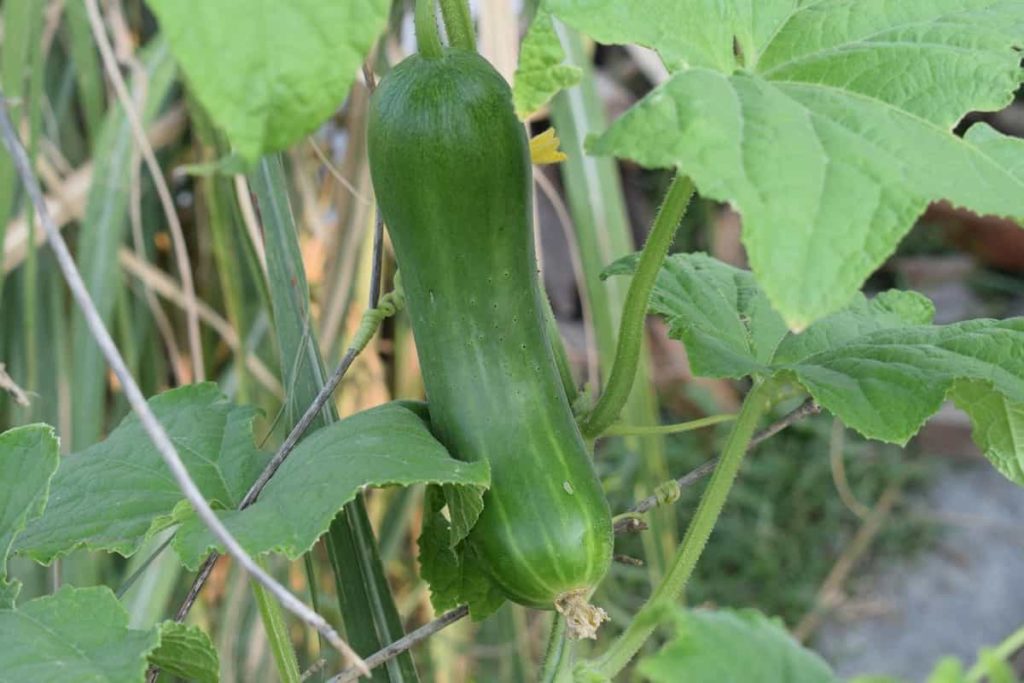
Other pests that affect production outside the greenhouse are arthropods such as watermelon thrips, leaf miners, banded Cucumber beetles, flea beetles, mites, stink bugs, wireworms, grasshoppers, leafhoppers, squash bugs, squash vine borers, and the looper. These pests are a serious concern for the grower, as Cucumber crops have little tolerance for pest damage. There are six different species of Cucumber beetles in the United States.
Three of these Cucumber beetles are found in Florida. The banded Cucumber beetle is native to southern Florida. Spotted Cucumber beetles and striped beetles are found in northern Florida. Pesticides are commonly used to combat bacterial wilt. As for the squash mosaic virus, which insects spread, once a plant is infected, it must be removed, so it does not infect other plants. In addition, preventive measures, such as weed control, can be attempted to avoid the virus’s presence.
Some techniques help reduce the chances of Cucumber disease. Commercial growers can use certified disease-free seeds and keep the garden and surrounding area free of weeds that harbor insects that can cause viruses and bacterial wilt. After harvest, growers should remove plant debris left behind in the garden as some diseases can survive on plant debris. Finally, an important measure in disease control is host resistance.
Glyphosphate is an herbicide that, if absorbed by Cucumbers, causes damage like leaf discoloration from light green to yellow, stunted growth, and upward curling. Fungicides are most useful when applied before infection and must be reapplied every five to seven days after infection. Some fungicides used are Previcur Flex, Gavel, Tanos, and Ranman.
Cucumber harvesting season in the USA
- Cucumbers should be harvested for the best flavor and texture when they are 1.25 to 2 inches in diameter and 6-8 inches in length, depending on the cultivar. Cucumbers are pollinated at different times, multiple hand harvests are necessary for the field, usually every other day. To ensure the marketing of a high-quality product, grade Cucumbers by using size and maturity and check them for insect damage.
- Pickles are usually harvested by machine and under contract with a local processor, although there is a limited market for fresh pickles.
- The United States harvests Cucumbers for two primary purposes: pickling and fresh marketing. About 11,200 farms in the northeastern states produced more than 6,600 acres of Cucumbers. The production value for the United States is over $410 million. Pennsylvania produced about 337 acres of Cucumbers, primarily for new marketing.
- Cucumbers are harvested at different stages, from young to mature, before the seeds finally mature and harden. Those harvested before seed maturity are sold seedless. The fruit is harvested when uniform length, shape, and diameter are reached and before the flower turns yellow at the end of flowering. Generally, crop length is determined by the target market.
Cucumber marketing in the USA
- Cucumber imports to the US have steadily increased over the past few years. It shows that market demand is increasing, although we should not ignore that Florida and Michigan, the main producing states, have had bad weather conditions. These adverse conditions have affected domestic production and forced the US to increase imports.
- There is also the fact that Mexico’s use of greenhouses and macro tunnels means that the country can produce Cucumbers almost year-round, a major competitive advantage that Mexican farmers have put to good use. As a result, they are now the main supplier of fresh Cucumbers to the US market.
- Mexico is the seventh largest producer and leading exporter of Cucumbers, accounting for 30 percent of global fresh Cucumber exports. The USA accounts for 36 percent of global imports of fresh Cucumbers. The United States consumes 1.6 million metric tons of Cucumbers each year and produces 636,000 tons, accounting for nearly one million tons of imports and more than 60 percent of the Cucumber supply.
- Mexico exports about 800,000 tons of fresh Cucumbers to the United States between November and May, while Canada exports 200,000 tons between March and October.
- Most US Cucumbers are grown in open fields. Michigan growers specialize in pickling machine-harvested Cucumbers, while growers in Florida, Georgia, and North Carolina specialize in hand-picked fresh or cut Cucumbers.
- Fresh market Cucumbers are usually available in Pennsylvania from late June through November. They are traditionally sold in 47 to 55-pound cardboard boxes. Marketing ways are available to the Cucumber grower like wholesale marketing, produce auctions, cooperatives, local retailers, roadside stands, and pick-your-own operations. When planning production, consider your ability to market first. It would mainly help if you did market research because most growers overestimate their ability to sell in a given market. Production of less than one acre of vegetable crops is common for most farmers.
- In wholesale marketing, producers contract with shippers to market and ship Cucumbers at a predetermined price. If you don’t use a contractor and ship your Cucumbers to the wholesale market, your product will be subject to the most price fluctuations. Production auctions run weekly. However, it would help if you delivered the Cucumbers to the auction. Marketing cooperatives typically use daily pooled costs and prices, which spread price fluctuations across all participating producers. Local retailers are another potential market, but you must take the time to contact production managers and provide good quality Cucumbers when stores need them. Depending on your growing location, processors may or may not be a marketing option. Processors are less likely to contract with small acreage growers (less than 5 acres).
Cucumber yield in the USA
The total expected yield depends directly on the harvesting period. Cucumber yields range from 1 to 3 pounds of fruit per week during the peak harvest period. A typical harvest period of about 12 weeks in a well-managed crop can yield 20-25 pounds of fruit per plant. High temperatures can cause discoloration and bitterness of the light green fruit in wide Cucumber varieties. Cucumbers will grow in almost any well-drained soil. A good Cucumber harvest in Oklahoma yields 300 bushels per acre, although much more is possible.
In case you missed it: Organic Cucumber Farming In Greenhouse
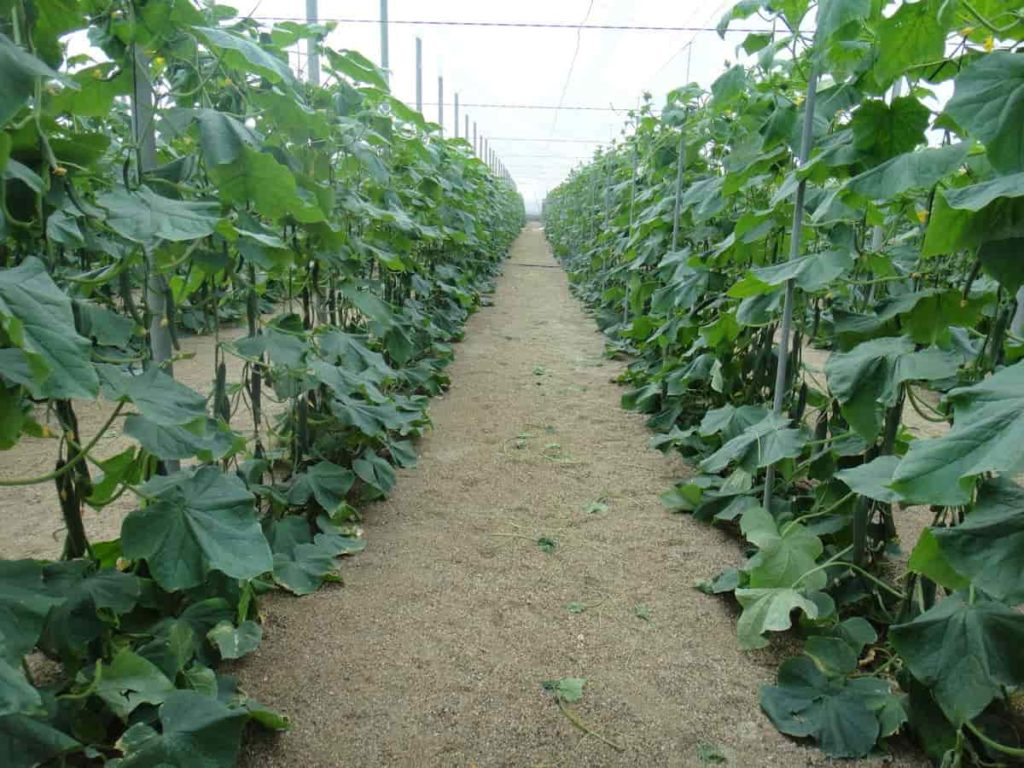
Frequently asked questions about Cucumber farming in the USA
Where are most Cucumbers grown in the US?
Florida is by far the leading producer of all varieties of fresh Cucumbers. At the same time, Michigan is the leading state producer of Cucumber varieties that are best suited for pickling. There are more Cucumber varieties for pickle production than all fresh markets combined.
Where does the US get Cucumbers from?
Nowadays, Cucumbers are mainly grown for fresh (slicing) and pickled (pickling) crops. Fresh produce is led by Florida and Georgia, although the US imports substantial amounts from Mexico, with smaller amounts from Canada, Honduras, and the Dominican Republic.
Is Cucumber cultivation profitable?
Cucumber cultivation can be very profitable if done correctly.
How much does a Cucumber cost in the US?
A kilo of Cucumbers in the US is about US$1.94 in Washington and New York, packed and ready for delivery.
In case you missed it: Cucumber Farming in Polyhouse (Kheera) for Profit
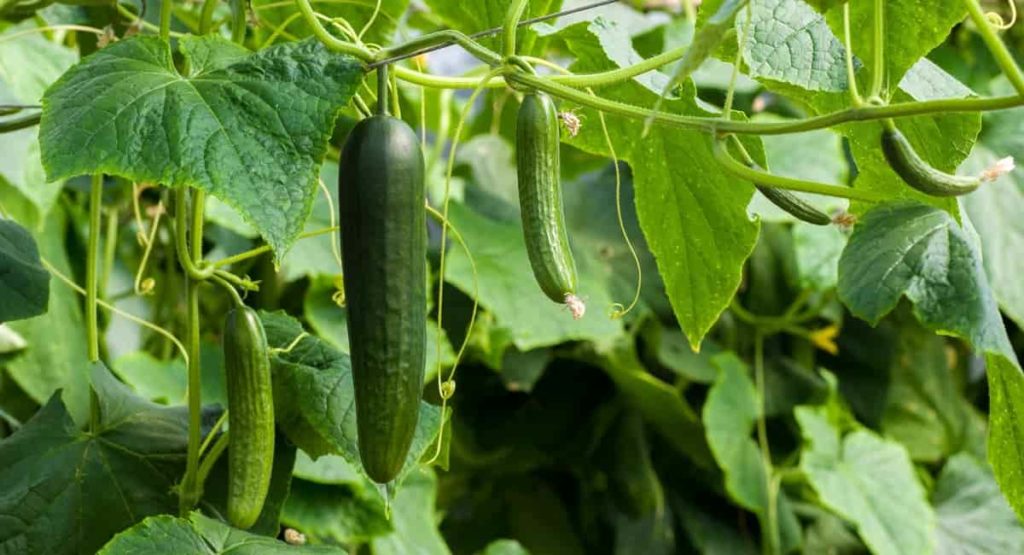
How often should Cucumbers be watered?
Give them full sun and room to grow, and train them on trellises or fences. Cucumbers do best with a regular, deep watering once a week and more frequently if the weather is very hot for a few days. Inadequate or inconsistent moisture can result in odd-shaped or poor-tasting fruit.
Is Cucumber profitable?
Cucumber farming is profitable if you undergo proper maintenance and management within the Cucumber farm.
Which fertilizer is best for Cucumbers?
Cucumber plants need moderate nitrogen and high phosphorus and potassium, so an organic plant food with the first number is lower than the last two (such as 3-4-6).
What is the secret to growing Cucumbers?
Cucumbers will grow quickly with little care. Cucumber plants get an inch of water each week. Do your best to grow your food by regularly feeding plants water-soluble nutrients.
Do Cucumbers need a lot of water to grow?
The main requirement of Cucumber care is constant watering. It needs at least an inch of water per week (or more if temperatures are particularly hot). Inconsistent watering leads to bitter-tasting fruit.
Why are my Cucumbers drying up and dying?
Cucumbers will wilt and die when soil or air temperatures become too cold for their liking. According to the University of Minnesota, Cucumbers begin to wilt and turn brown when low soil temperatures.
What are the most common diseases affecting Cucumbers?
Angular leaf spot, bacterial wilt, Phytophthora crown, root rot, and powdery mildew are important diseases of Cucumber. The timing of these diseases’ occurrence, severity, and resulting losses vary by geographic region.
In case you missed it: Cucumber Farming Profit, Cultivation Cost, Project Report
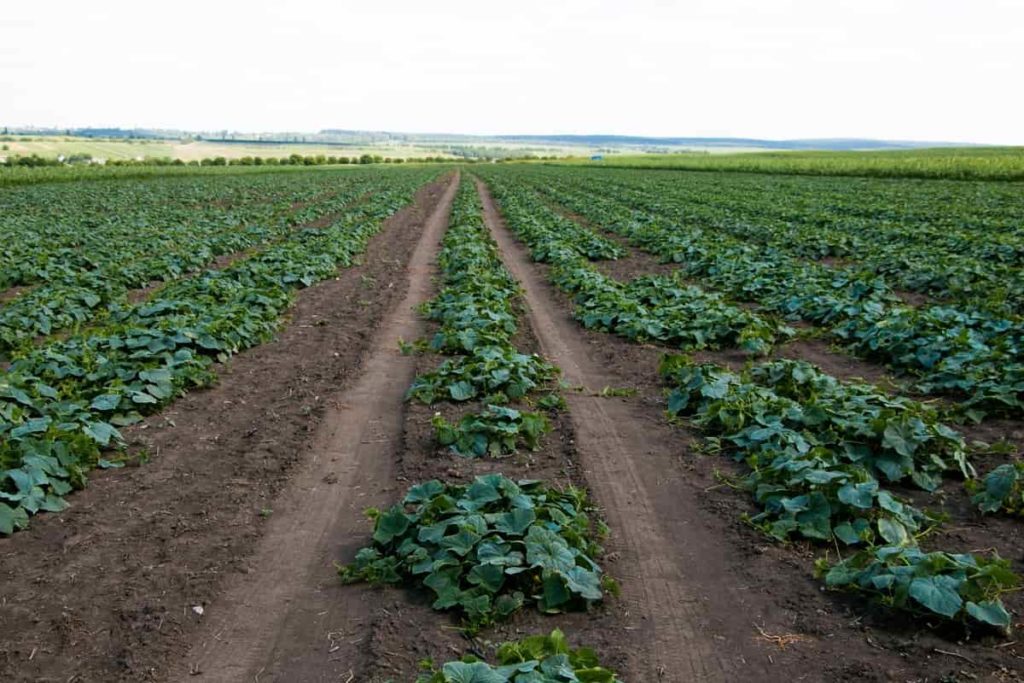
What do overwatered Cucumbers look like?
Yellowing of plant leaves is a common symptom of overwatering. When roots sit in water, they become damaged and unable to absorb nutrients. When leaves turn yellow from overwatering, they often become stunted and limp and may drop. When this happens, check the drainage around the base of the Cucumber and reduce the water.
Why are my Cucumber plant leaves turning yellow and dying?
As your Cucumbers and squash grow, you may find the leaves turning yellow and dying. It is the main sign that something is wrong with your Cucumber plants. The common cause of yellowing leaves is that you have a water problem. It means you are either watering your plant too much or too little.
How much time does it take to grow Cucumbers?
It mainly depends on the variety, climatic conditions, nutrients, etc. Generally, Cucumber plants take about 55 to 70 days from germination to the harvest stage.
A source: https://www.agrifarming.in
